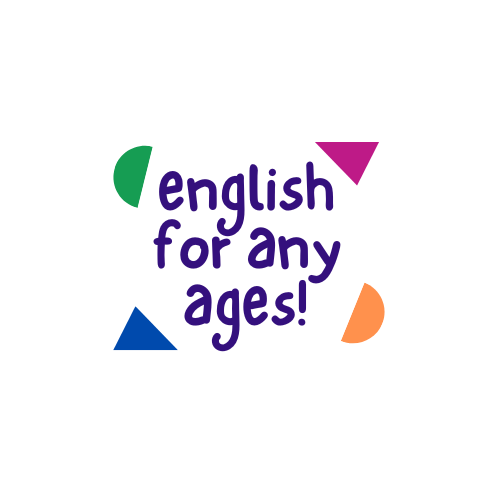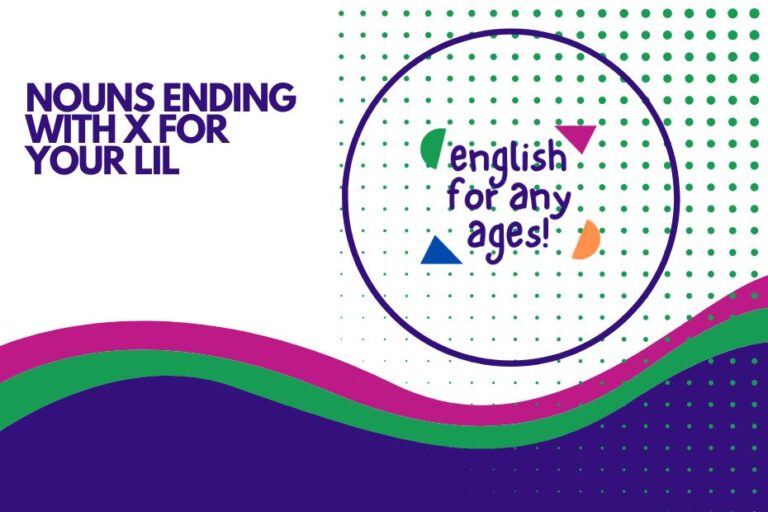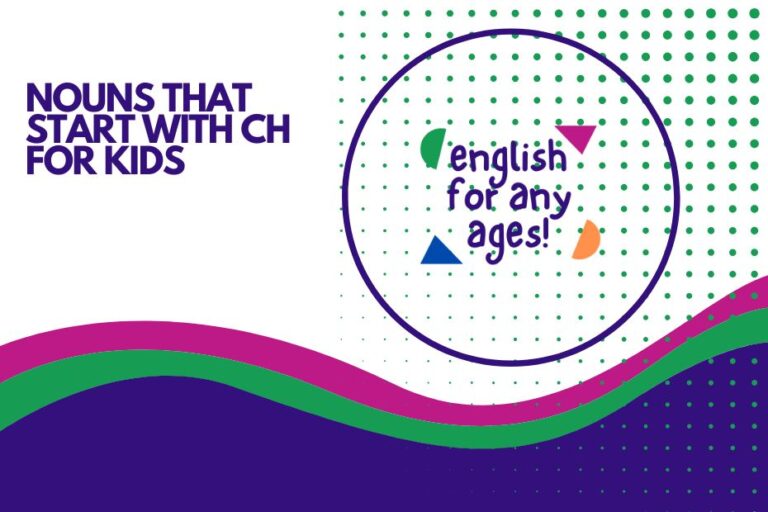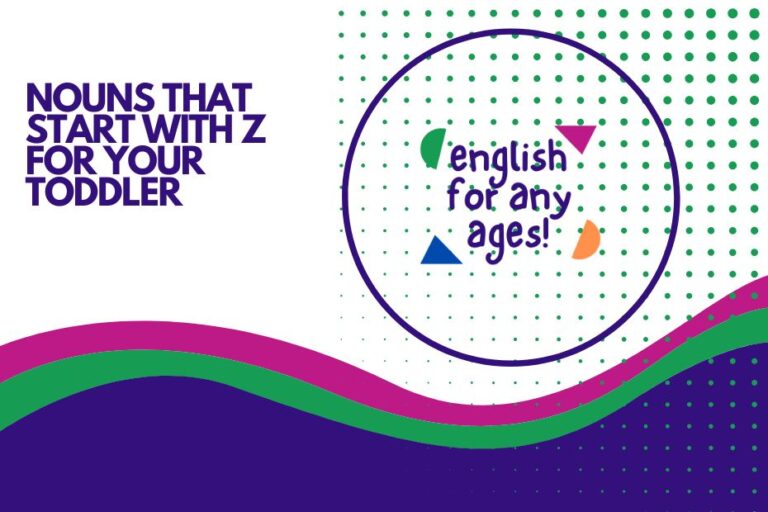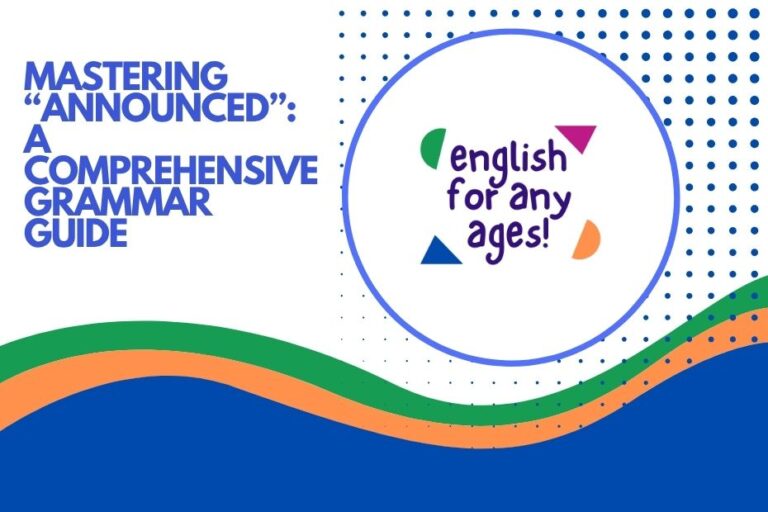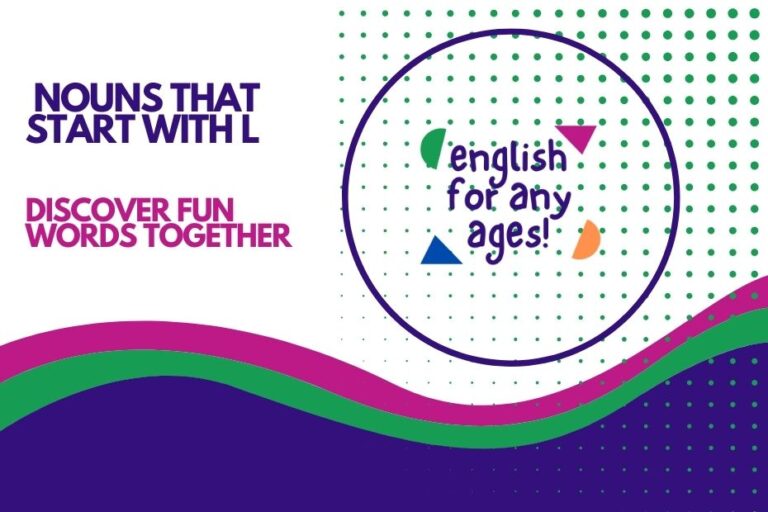Noun Definition With Examples – A Complete Guide with Exploring All Types
A noun is the foundation of any sentence in English grammar. It serves as a naming word for people, places, things, or ideas.
A noun is a word that answers questions like Who? What? Where? It gives names to the elements around us, whether tangible or intangible.
Examples of Nouns in Sentences:
- Mary is reading a book. (Mary is a person, book is a thing.)
- The park is full of flowers. (Park is a place, flowers are things.)
- Kindness changes lives. (Kindness is an idea or concept.)
In this article, we’ll explore the types of nouns, explore their meanings, and provide examples with detailed explanations.
By the end, you’ll have a thorough understanding of nouns and their role in effective communication.
Types of Nouns – A Close Look Table
| Serial | Type of Noun | Description | Example | Explanation |
|---|---|---|---|---|
| 1. | Proper Noun | Specific name, always capitalized | Eiffel Tower | Refers to a specific monument. |
| 2. | Common Noun | General name for a person, place, or thing | teacher | Refers to any teacher, not a specific one. |
| 3. | Abstract Noun | Represents an idea, quality, or state | freedom | Cannot be perceived physically; exists conceptually. |
| 4. | Concrete Noun | Something tangible, perceived through senses | chair | Can be seen and touched. |
| 5. | Collective Noun | Represents a group considered as one unit | flock | Refers to a group of birds. |
| 6. | Countable Noun | Can be counted and has singular/plural forms | apple | You can count apples (e.g., one apple, two apples). |
| 7. | Uncountable Noun | Substances or concepts that cannot be counted individually | sand | Measured in quantities, not individually counted. |
| 8. | Compound Noun | Formed by combining two or more words | sunflower | Combines “sun” and “flower” into one word. |
| 9. | Singular and Plural Nouns | Refers to more than one person, place, or thing | cars | Indicates more than one car. |
| 10. | Possessive Noun | Shows ownership or possession | dog’s tail | Indicates the tail belongs to the dog. |
| 11. | Appositive Noun | Renames or provides more information about another noun | My friend, Sarah, is here. | “Sarah” gives more detail about “my friend.” |
| 12. | Attributive Noun | Functions as an adjective to modify another noun | chicken soup | “Chicken” describes the type of soup. |
| 13. | Generic Noun | Refers to a general class or category | doctor | Refers to any doctor, not a specific one. |
| 14. | Gerunds | A noun formed by adding -ing to a verb | reading | Refers to the activity of reading, used as a noun. |
| 15. | Verbal Noun | Derived from a verb but lacks verb-like properties | His writing is excellent. | “Writing” refers to the product of his action, not the action itself. |
Lets go for details.
1. Proper Nouns
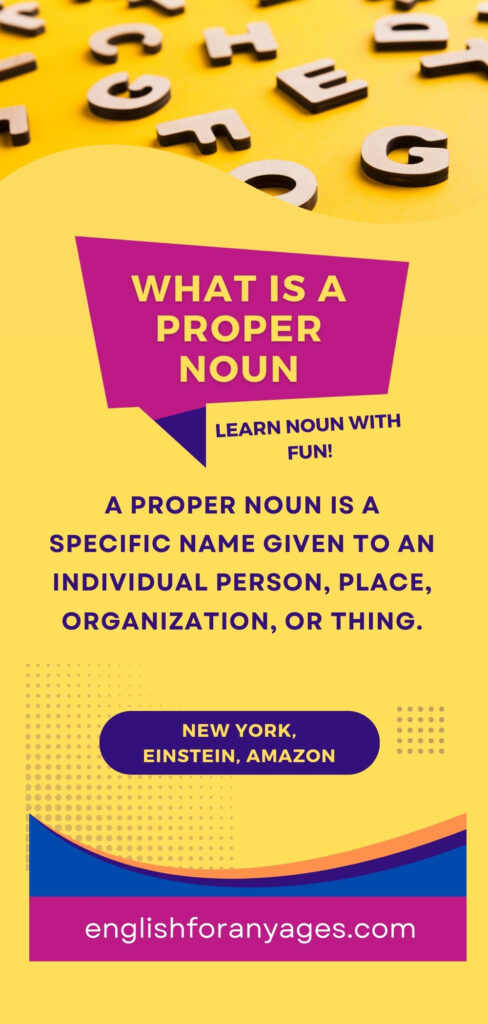
A proper noun is a specific name given to an individual person, place, organization, or thing.
Unlike common nouns, which are general names, proper nouns always begin with a capital letter, regardless of where they appear in a sentence.
Proper nouns uniquely identify an entity and distinguish it from others of the same kind.
Features of a Proper Noun
- Uniqueness: Denotes one-of-a-kind items or entities.
- Specific Name: Refers to a particular entity, not a general category.
- Capitalization: Always starts with a capital letter.
Proper Noun Examples with Explanations
Example Sentence: New York City is a bustling metropolis with a rich cultural history.
Explanation: “New York City” is a proper noun because it names a specific city, making it distinct from other cities.
Example Sentence: Albert Einstein revolutionized physics with his groundbreaking theories.
Explanation: “Albert Einstein” is a proper noun as it refers to a specific, renowned physicist, distinguishing him from all other individuals.
Example Sentence: The Eiffel Tower attracts millions of tourists each year.
Explanation: “The Eiffel Tower” is a proper noun because it names a unique landmark in Paris, unlike a general term like “tower.”
Example Sentence: Amazon delivers products to customers worldwide.
Explanation: “Amazon” is a proper noun as it refers to a specific e-commerce company, differentiating it from general nouns like “company” or “store.”
Example Sentence: Monday is often considered the least favorite day of the week.
Explanation: “Monday” is a proper noun because it identifies a specific day of the week, setting it apart from other days.
Importance of Proper Nouns
- Clarity: Proper nouns eliminate ambiguity by precisely naming entities.
- Correctness: Proper capitalization enhances the grammatical quality of writing.
- Specificity: Ensures accurate identification in communication.
Understanding proper nouns allows for more effective and specific expression in writing and speaking!
2. Common Nouns
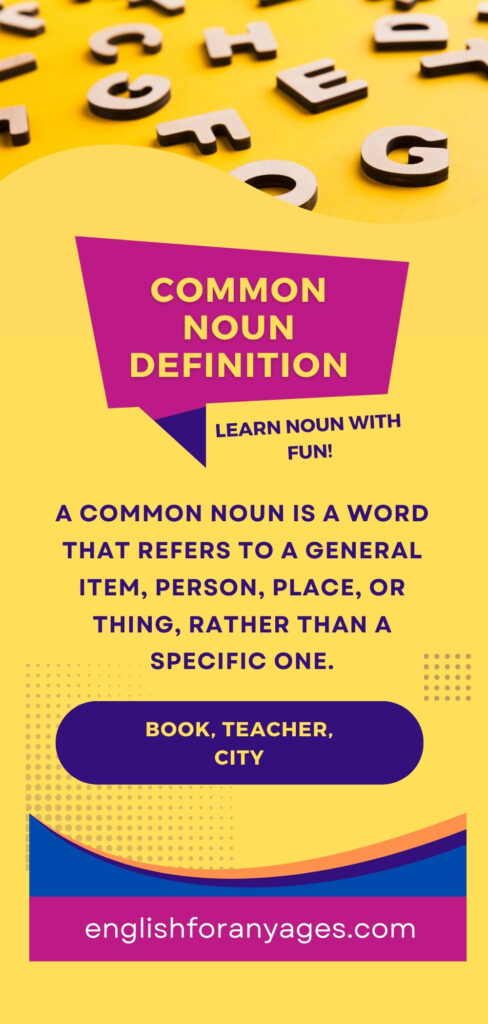
A common noun is a word that refers to a general item, person, place, or thing, rather than a specific one. It is a general name used to describe a class of objects or a category of things.
Common nouns do not start with capital letters unless they are at the beginning of a sentence or part of a title.
They can be concrete (things you can see or touch) or abstract (things you cannot see or touch, like feelings or ideas).
Examples of Common Noun with explanations
Example Sentence: I enjoy reading a book before bed.
Explanation: The word book refers to any book in general, not a particular one.
Example Sentence: The teacher is explaining the lesson.
Explanation: The word teacher does not refer to any specific person but to the role or profession.
Example Sentence: I am planning to visit a new city this summer.
Explanation: City is a general term for a place, not a specific one.
Example Sentence: The dog is barking loudly.
Explanation: The word dog refers to any dog and not to a specific dog.
Example Sentence: Happiness is important for mental well-being.
Explanation: Happiness is not a specific instance of joy but the general concept or feeling of being happy.
Common nouns are vital in everyday language as they provide general terms that people use to identify categories of things, making communication clear and efficient.
Key Tip:
Common nouns become proper nouns when they name something specific. For instance, teacher (common noun) becomes Mr. Smith (proper noun).
3. Abstract Nouns
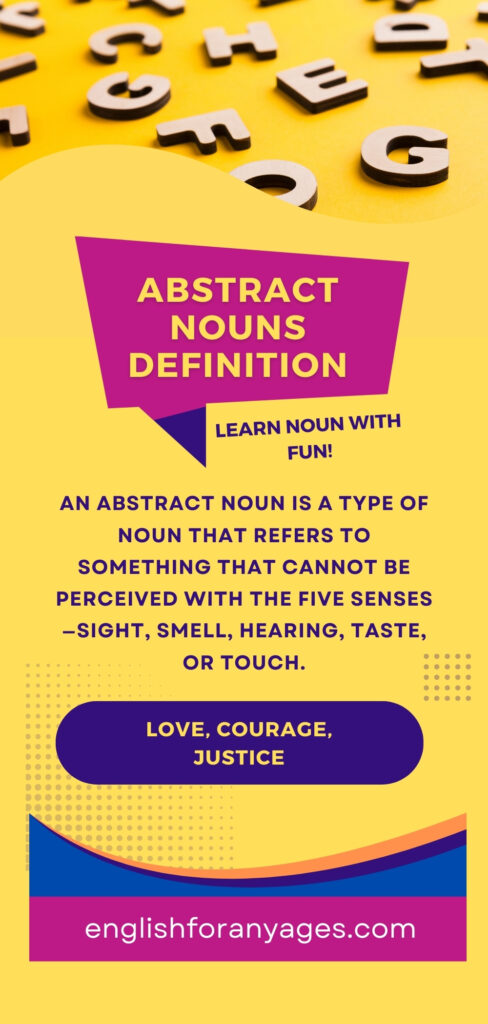
An abstract noun is a type of noun that refers to something that cannot be perceived with the five senses—sight, smell, hearing, taste, or touch.
It represents an idea, quality, state, or emotion that is intangible and does not have a physical existence.
Unlike concrete nouns, which refer to objects or things we can physically experience, abstract nouns are things we can think about but cannot physically interact with.
Characteristics of Abstract Nouns
- Intangible: You cannot touch, see, smell, or hear an abstract noun.
- Emotional or conceptual: They often refer to feelings, qualities, or states of being.
- Ideas and concepts: They represent abstract concepts that exist in our minds or society but don’t have a physical form.
Examples of Abstract Noun with explanations
Example Sentence: Their love for each other is evident.
Explanation: Love is a strong emotion that cannot be physically touched or seen.
Example Sentence: She felt a deep sense of happiness after receiving the good news.
Explanation: Happiness is an emotional state, not a tangible object.
Example Sentence: Freedom is essential for a happy life.
Explanation: Freedom refers to the condition of being free, which is a conceptual idea rather than a physical thing.
Example Sentence: He showed great courage during the crisis.
Explanation: Courage is a quality or characteristic that exists in a person’s mind and actions.
Example Sentence: The justice system aims to ensure fairness.
Explanation: Justice is an abstract idea about the application of fairness, not a physical object.
- Love – Love is an abstract noun because it refers to a feeling or emotion, which cannot be seen or touched.
- Example: Their love for each other is evident.
- Explanation: Love is a strong emotion that cannot be physically touched or seen.
- Happiness – Happiness refers to a state of joy or contentment, an abstract feeling.
- Example: She felt a deep sense of happiness after receiving the good news.
- Explanation: Happiness is an emotional state, not a tangible object.
- Freedom – Freedom represents the idea or concept of being free and independent, something we cannot physically hold.
- Example: Freedom is essential for a happy life.
- Explanation: Freedom refers to the condition of being free, which is a conceptual idea rather than a physical thing.
- Courage – Courage is the quality of being brave, often in the face of fear or difficulty, and is not something that can be touched or seen.
- Example: He showed great courage during the crisis.
- Explanation: Courage is a quality or characteristic that exists in a person’s mind and actions.
- Justice – Justice refers to the concept of fairness and moral rightness, something we cannot physically experience.
- Example: The justice system aims to ensure fairness.
- Explanation: Justice is an abstract idea about the application of fairness, not a physical object.
Abstract nouns are significant because they help express concepts, ideas, emotions, and qualities that are fundamental to human experience, even though they cannot be physically interacted with.
Ask yourself: Can I touch or see it? If the answer is no, it’s likely an abstract noun.
4. Concrete Nouns
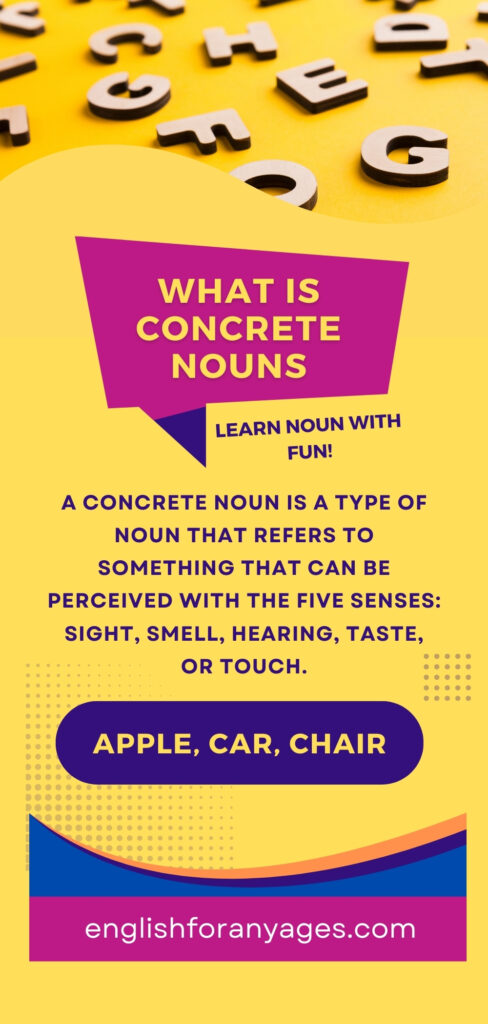
A concrete noun is a type of noun that refers to something that can be perceived with the five senses: sight, smell, hearing, taste, or touch.
These nouns represent things that exist physically and can be experienced or interacted with in the real world.
Concrete nouns are tangible and have a physical presence, unlike abstract nouns, which refer to ideas, emotions, or concepts.
Characteristics of Concrete Nouns
- Tangible: Concrete nouns refer to things that you can see, touch, hear, taste, or smell.
- Physical existence: They represent objects, people, animals, or places that exist in the physical world.
Examples with explanations
Example Sentence: I ate a red apple for breakfast.
Explanation: The apple is a real, tangible item that you can hold and eat.
Example Sentence: The dog barked loudly at the mailman.
Explanation: The dog is a living being that exists in the physical world and can be interacted with.
Example Sentence: She sat in the comfortable chair by the window.
Explanation: The chair is a physical object that you can see and feel.
Example Sentence: His car broke down on the way to work.
Explanation: The car is a physical object that can be experienced through sight and touch.
Example Sentence: We hiked up the tall mountain during our vacation.
Explanation: The mountain is a physical feature of the landscape that you can see and touch.
Concrete nouns are essential in everyday communication because they allow us to talk about real-world objects and experiences.
These nouns make it easier to describe the tangible aspects of life, from objects and places to living creatures.
Example: Her courage (abstract) was as solid as a rock (concrete).
5. Collective Nouns
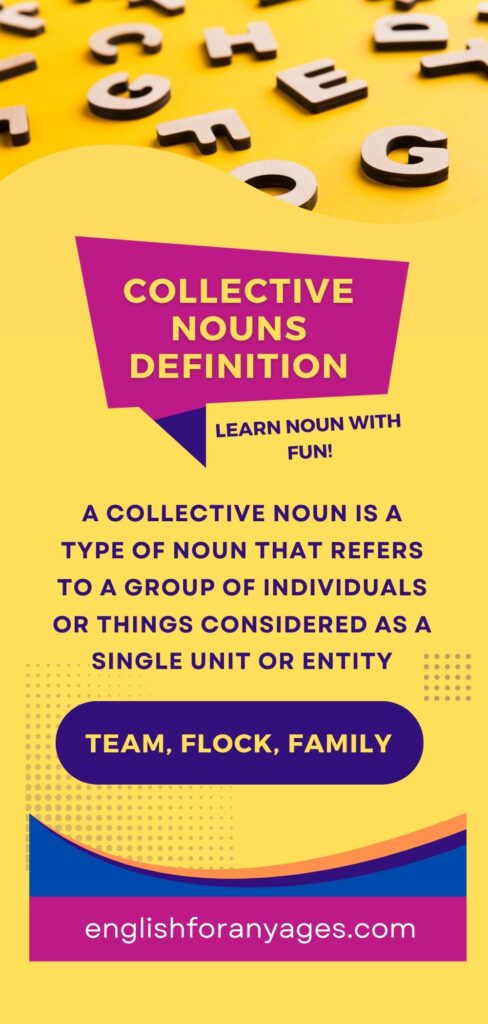
A collective noun is a type of noun that refers to a group of individuals or things considered as a single unit or entity.
These nouns are used to represent a collection of people, animals, or things, and although the group may consist of multiple members, the collective noun itself is treated as singular in terms of grammar.
Characteristics of Collective Nouns
- Group or collection: A collective noun represents a group of things or people.
- Singular form: Even though a collective noun refers to multiple members, it is usually treated as a singular noun when used in sentences.
- Can refer to people, animals, or objects: Collective nouns can describe groups of individuals, animals, or objects, depending on the context.
Examples with explanations
Example Sentence: The team won the championship.
Explanation: The team is considered as one entity, even though it is made up of multiple players.
Example Sentence: The flock of birds flew south for the winter.
Explanation: The flock is a single group of birds, even though it consists of many individual birds.
Example Sentence: The family is going on a vacation next week.
Explanation: The family is treated as a single unit, even though it includes multiple members.
Example Sentence: The class will have a test tomorrow.
Explanation: The class is considered as a single group, even though it consists of several students.
Example Sentence: The herd of elephants moved across the savanna.
Explanation: The herd is a group of elephants treated as a single entity.
Collective nouns are useful for simplifying sentences when discussing groups of people, animals, or objects.
They help us communicate more efficiently by referring to a collection as one unit rather than listing each member individually.
6. Countable Noun
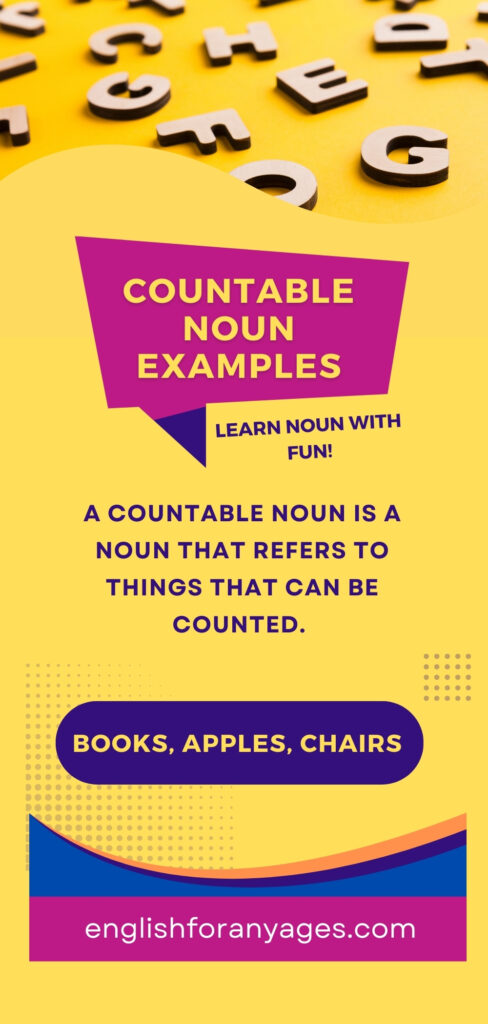
A countable noun is a noun that refers to things that can be counted. These nouns have both singular and plural forms and can be counted individually.
Countable nouns represent items that can be quantified, such as books, apples, chairs, and cars.
Key Features of Countable Nouns
Can Be Counted
Countable nouns can be counted as individual units or items.
Example: One book, two books, three books.
Have Singular and Plural Forms
Countable nouns can take both singular and plural forms.
Singular: a book, an apple
Plural: books, apples
Can Be Used with Numbers or Quantifiers
Countable nouns can be used with numbers or quantifiers like “many,” “few,” or “several.”
Example: “I have three books.” or “There are many apples.”
Can Be Used with “a” or “an” in the Singular Form
Since countable nouns are considered individual items, they can be used with the articles “a” or “an” in their singular form.
Example: “I have a dog.” or “She bought an orange.”
Examples of Countable Nouns
Books
Singular: book
Plural: books
Example: I bought three books yesterday.
Apples
Singular: apple
Plural: apples
Example: There are five apples on the table.
Cars
Singular: car
Plural: cars
Example: He owns two cars.
Chairs
Singular: chair
Plural: chairs
Example: There are four chairs in the room.
Dogs
Singular: dog
Plural: dogs
Example: She has two dogs.
Functions of Countable Nouns
As the Subject of a Sentence
Example: Books are important for learning.
Explanation: Books is the subject of the sentence.
As the Object of a Verb
Example: I bought two apples.
Explanation: Apples is the object of the verb “bought.”
After Numbers
Example: She has four dogs.
Explanation: Dogs is used with the number “four.”
With Quantifiers
Example: I have many friends.
Explanation: Friends is used with the quantifier “many.”
Countable vs. Uncountable Nouns
Countable Nouns
Things that can be counted individually.
Example: Books, chairs, dogs
Can be used with numbers and articles like “a” or “an”.
Uncountable Nouns
Things that cannot be counted individually.
Example: Water, sand, sugar
Cannot be used with numbers or articles like “a” or “an”.
7. Uncountable Noun
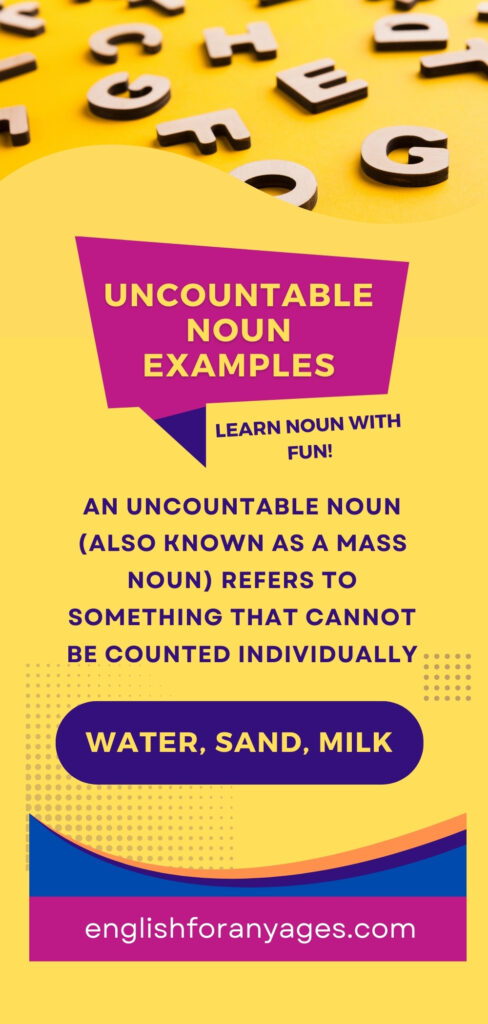
An uncountable noun (also known as a mass noun) refers to something that cannot be counted individually because it represents a whole or mass that is not divided into separate elements.
These nouns often represent substances, concepts, or abstract ideas that are not easily counted.
Characteristics of Uncountable Nouns
- Cannot be counted: Uncountable nouns are not counted in individual units. Instead, they are often measured in terms of volume, weight, or quantity.
- Do not have a plural form: Uncountable nouns generally do not change to the plural form (e.g., water stays water, not waters).
- Use of “much”: We usually use the word much with uncountable nouns in questions or negative sentences (e.g., “How much water?”).
Types of Uncountable Nouns
Examples: Water, sand, milk, oil, bread, salt.
Explanation: These are physical things that cannot be counted as individual items. They are measured by volume or mass, not by count.
Examples: Love, happiness, education, advice, knowledge, progress.
Explanation: These intangible things cannot be counted individually. They represent ideas or emotions, not physical objects.
Examples: Furniture, luggage, clothing, traffic.
Explanation: These are collective terms that refer to a mass of similar things or collections that are not counted individually.
Examples: Weather, air, rain, snow, lightning.
Explanation: Certain things in nature, such as weather and air, are considered uncountable because they are not individual items but rather collective phenomena.
- Substances or materials: These are physical things that cannot be counted as individual items.
- Examples: Water, sand, milk, oil, bread, salt.
- Abstract ideas or concepts: These are intangible things that are not counted individually.
- Examples: Love, happiness, education, advice, knowledge, progress.
- Groupings of similar things: Some collective terms refer to a mass of similar things or a collection that cannot be counted individually.
- Examples: Furniture, luggage, clothing, traffic.
- Natural phenomena: Certain things in nature are considered uncountable.
- Examples: Weather, air, rain, snow, lightning.
Examples of Uncountable Nouns with Explanations
Example: I need some water.
Explanation: We don’t count water in individual units like “waters,” but instead use “some” or measure it (e.g., “two liters of water”).
Example: The information you provided is very useful.
Explanation: Information is an uncountable noun, so we don’t say “informations.”
Example: How much sugar do you want in your tea?
Explanation: Sugar cannot be counted as individual pieces but is instead measured (e.g., teaspoons, grams).
Example: She gave me some good advice.
Explanation: Advice is a non-countable noun, so it is not pluralized as “advices.”
- Water – Water is a substance that cannot be counted individually.
- Example: I need some water.
- Explanation: We don’t count water in individual units like “waters,” but instead use “some” or measure it (e.g., “two liters of water”).
- Information – Information refers to data or knowledge and is not counted in individual pieces.
- Example: The information you provided is very useful.
- Explanation: Information is an uncountable noun, so we don’t say “informations.”
- Sugar – Sugar is a substance that is measured in terms of weight or quantity, not counted.
- Example: How much sugar do you want in your tea?
- Explanation: Sugar cannot be counted as individual pieces but is instead measured (e.g., teaspoons, grams).
- Advice – Advice is a concept, not something that can be counted.
- Example: She gave me some good advice.
- Explanation: Advice is a non-countable noun, so it is not pluralized as “advices.”
- Music – Music is an art form that cannot be counted as separate units.
- Example: I love listening this music.
- Explanation: Music is an uncountable noun and does not have a plural form.
Quantifying Uncountable Nouns
Although uncountable nouns cannot be counted directly, we can express them in terms of quantity by using words like “some,” “much,” “a lot of,” “a little,” or specific measurements.
- Examples:
- Some water
- Much sugar
- A little advice
- A lot of furniture
Summary
- Uncountable nouns represent things that cannot be counted individually, like substances, abstract ideas, and collective terms.
- They do not have plural forms and are typically quantified using words like “some,” “much,” or specific measurements.
- Examples include water, music, advice, furniture, and knowledge.
8. Compound Nouns
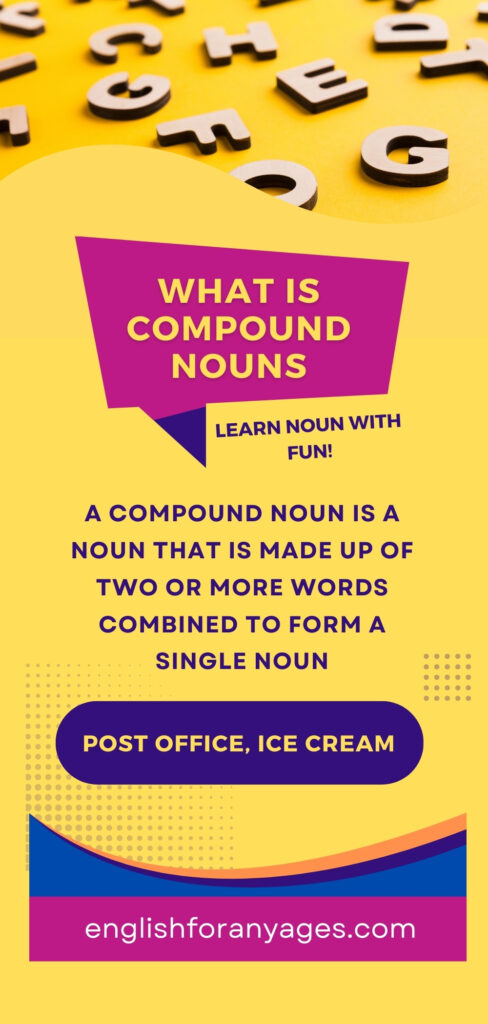
A compound noun is a noun that is made up of two or more words combined to form a single noun.
These words can be combined in different ways, such as two separate words, hyphenated words, or single words.
Compound nouns represent a single concept and can describe a variety of things, from objects to actions, or even concepts.
3 Types of Compound Nouns
- Open compound nouns – Two words are used together without any punctuation (e.g., post office, ice cream).
- Hyphenated compound nouns – The two words are connected with a hyphen (e.g., mother-in-law, check-in).
- Closed compound nouns – The two words are combined into a single word without any spaces or hyphens (e.g., toothbrush, sunlight).
Examples with explanations
Example Sentence: I bought a new toothbrush today.
Explanation: The words tooth and brush are combined to form a single object used for brushing teeth.
Example Sentence: I need to go to the post office to mail this letter.
Explanation: Post office refers to a specific location that handles mail, even though it is made of two separate words.
Example Sentence: My mother-in-law is coming over for dinner.
Explanation: Mother-in-law refers to a specific family relationship, combining three words with hyphens.
Example Sentence: The room was filled with bright sunlight.
Explanation: Sunlight is a single word describing the light from the sun.
Example Sentence: We sat by the fireplace during the winter evening.
Explanation: The words fire and place are combined to describe a location designed for a fire.
9. Singular and Plural Nouns
Singular and plural nouns are essential in grammar to indicate whether we are referring to one person, thing, or idea (singular) or more than one (plural).
Here’s an overview of singular and plural nouns:
Singular Nouns
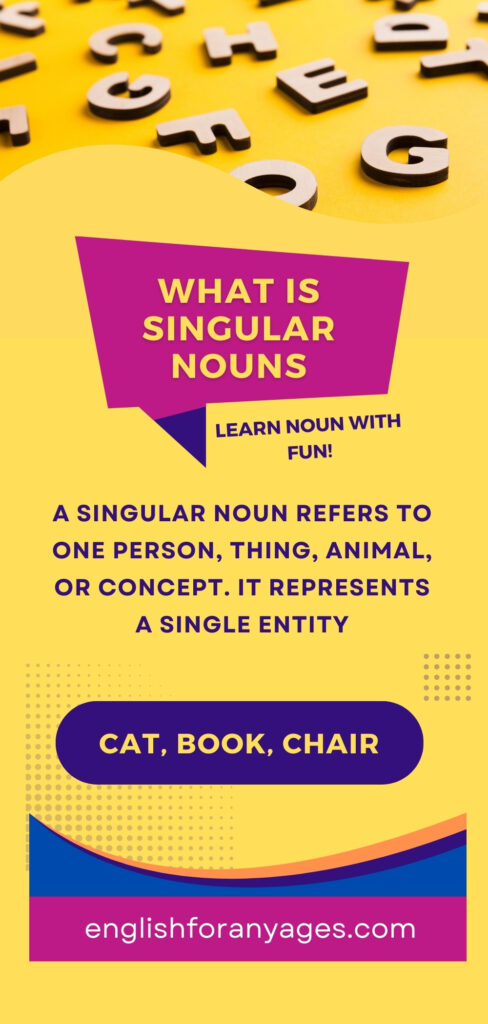
A singular noun refers to one person, thing, animal, or concept. It represents a single entity.
Example Sentence: The cat is sleeping.
Explanation: Cat refers to one single animal.
Example Sentence: I am reading a book.
Explanation: Book refers to one single item.
Example Sentence: The child is playing outside.
Explanation: Child refers to one single person.
Plural Nouns
A plural noun refers to more than one person, thing, animal, or concept.
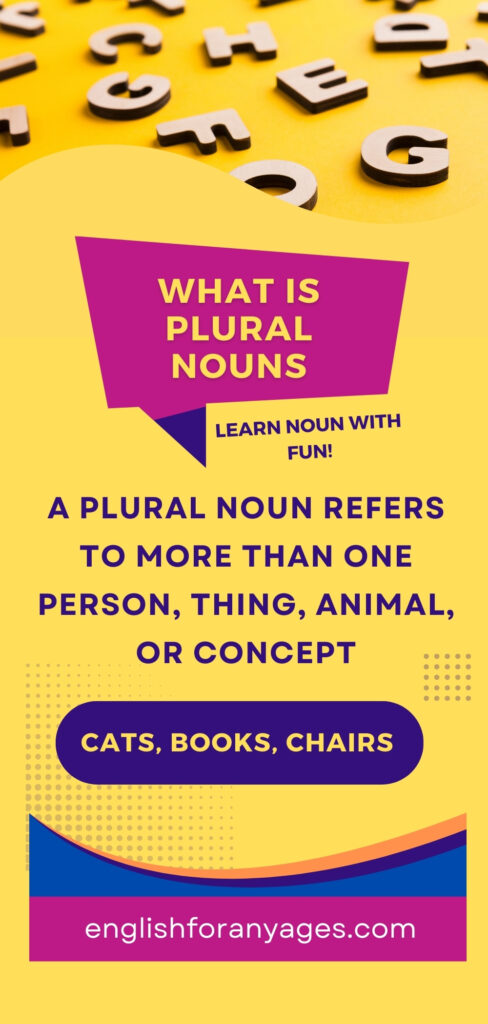
Plural nouns are typically formed by adding “s” or “es” to the singular form, but some nouns have irregular plural forms.
Example Sentence: The cats are playing together.
Explanation: Cats refers to more than one cat.
Example Sentence: I have many books on my shelf.
Explanation: Books refers to more than one book.
Example Sentence: The children are at the park.
Explanation: Children is the plural of child.
Example: Car → Cars
Example: Dog → Dogs
Explanation: Add “s” to most nouns to make them plural.
Example: Box → Boxes
Example: Brush → Brushes
Explanation: Add “es” to form the plural.
Example: Baby → Babies
Example: City → Cities
Explanation: Change “y” to “ies” for the plural.
Example: Boy → Boys
Example: Day → Days
Explanation: Add “s” to nouns ending in vowel + “y”.
Example: Man → Men
Example: Woman → Women
Example: Child → Children
Example: Foot → Feet
Explanation: Some nouns have irregular plural forms.
Example: Fish → Fish
Example: Deer → Deer
Explanation: Some nouns do not change in the plural form.
Summary
- Singular nouns refer to one item or person.
- Plural nouns refer to more than one item or person.
- Most plural nouns are formed by adding “s” or “es,” but some have irregular forms that must be memorized.
Quick Tip:
Most nouns become plural by adding -s or -es, but irregular nouns like child → children need special attention.
10. Possessive Nouns
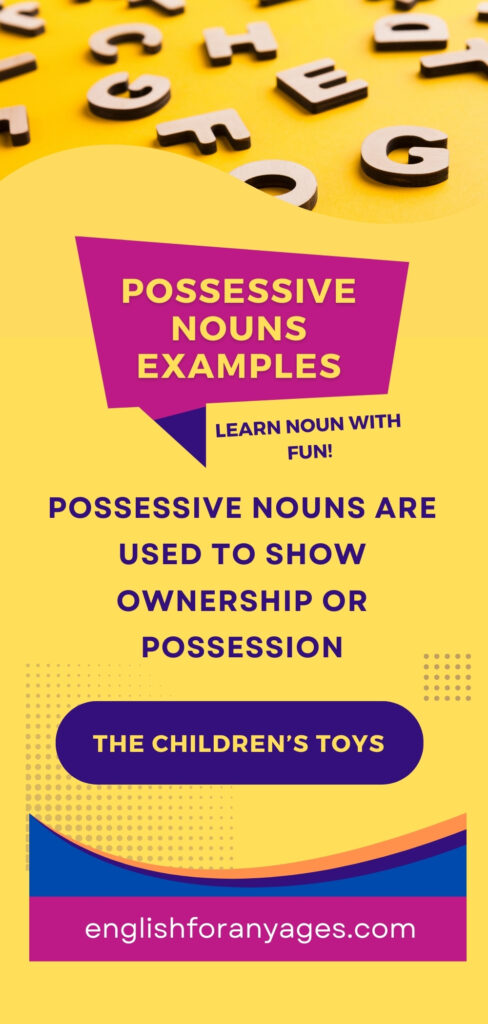
Possessive nouns are used to show ownership or possession. These nouns indicate that something belongs to someone or something.
A possessive noun is typically formed by adding an apostrophe (‘) and, in most cases, an s to the end of the noun.
Rules for Forming Possessive Nouns
Example: The dog’s bone.
Explanation: The bone belongs to the dog. To make a singular noun possessive, add ‘s.
Example: The dogs’ bones.
Explanation: The bones belong to more than one dog. Add an apostrophe (‘) after the s if the plural noun ends in s.
Example: The children’s toys.
Explanation: The toys belong to the children. Add ‘s if the plural noun does not end in s.
Example: Sarah’s book.
Explanation: The book belongs to Sarah. Add ‘s for singular proper nouns.
Example: The Smiths’ house.
Explanation: The house belongs to the Smith family. Add ‘ for plural proper nouns.
Example: The boy’s bicycle is new.
Explanation: The bicycle belongs to the boy. The possessive form of boy indicates that something belongs to one boy.
Example: The teacher’s desk is neat.
Explanation: The desk belongs to the teacher. The possessive form of teacher shows ownership.
Example: The parents’ decision was final.
Explanation: The decision was made by the parents. The plural possessive form of parents indicates something belongs to multiple parents.
Example: The women’s bathroom is on the left.
Explanation: The bathroom belongs to the women. The possessive form of women, which is plural and does not end in “s,” adds ‘s.
Example: The dogs’ collars are colorful.
Explanation: The collars belong to the dogs. The plural possessive form of dogs, since it ends in ‘s’, only requires an apostrophe.
Summary:
- Possessive nouns show ownership and are formed by adding ‘s or ‘ to the noun, depending on whether the noun is singular or plural.
- Singular nouns: Add ‘s (e.g., cat’s toy).
- Plural nouns (ending in s): Add ‘ (e.g., dogs’ toys).
- Plural nouns (not ending in s): Add ‘s (e.g., children’s toys).
- Proper nouns follow the same rules for possession.
Using possessive nouns correctly helps clarify ownership and relationships between objects and their owners.
11. Appositive Noun
An appositive noun is a noun or noun phrase placed next to another noun to explain, rename, or provide additional information about it.
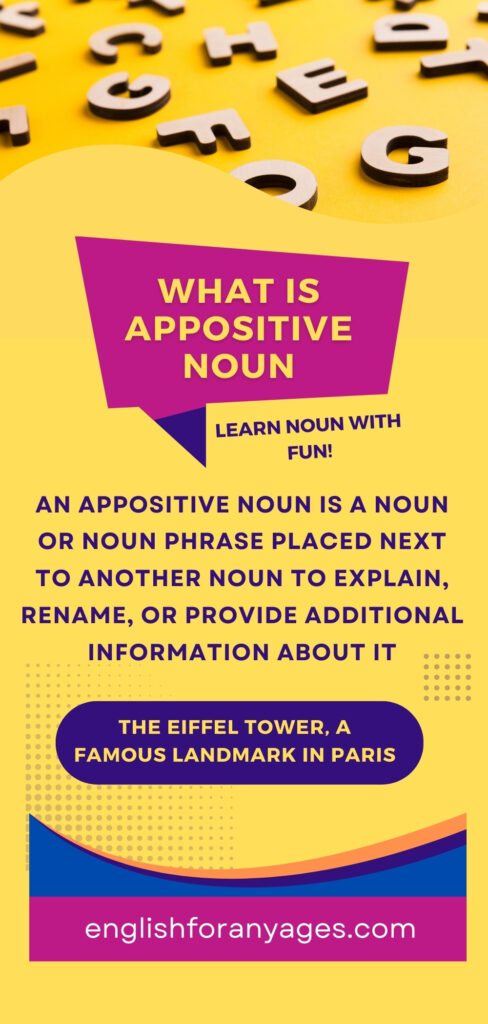
Appositive nouns are often used to clarify or elaborate on the preceding noun.
Key Features of Appositive Nouns
- Provides Explanation or Identification: The appositive noun gives more detail about the noun it follows.
- Placed Next to the Main Noun: It immediately follows the noun it explains or renames.
- Can Be Essential or Non-Essential:
- Essential Appositive: Provides critical information and does not use commas.
- Non-Essential Appositive: Adds extra information and is separated by commas.
Types of Appositive Nouns
Necessary to understand the meaning of the sentence.
Does not use commas.
Example: My friend John is visiting tomorrow.
Explanation: The appositive John identifies which friend is being referred to.
Provides additional, non-critical information.
Uses commas to set it apart.
Example: My dog, a Golden Retriever, loves to play fetch.
Explanation: The appositive a Golden Retriever gives extra information about the dog.
Examples of Appositive Nouns with Explanation
The author J.K. Rowling wrote the Harry Potter series.
Appositive: J.K. Rowling
Explanation: The appositive renames the author and specifies who the author is.
My brother, a talented musician, performed last night.
Appositive: a talented musician
Explanation: The appositive provides extra information about my brother.
Our teacher Mr. Smith is very kind.
Appositive: Mr. Smith
Explanation: The appositive specifies which teacher is being referred to.
The Eiffel Tower, a famous landmark in Paris, attracts millions of visitors.
Appositive: a famous landmark in Paris
Explanation: The appositive adds detail about the Eiffel Tower.
The movie director Steven Spielberg is known for his blockbuster films.
Appositive: Steven Spielberg
Explanation: The appositive renames the movie director and specifies who he is.
Functions of Appositive Nouns
- Clarify the Noun:
- Example: My friend Alex is coming over.
- Explanation: The appositive clarifies which friend is being referred to.
- Add Detail:
- Example: Mount Everest, the tallest mountain in the world, is a popular climbing destination.
- Explanation: The appositive provides extra detail about Mount Everest.
- Rename or Specify:
- Example: The river Nile is the longest in the world.
- Explanation: The appositive specifies the name of the river.
Summary
- An appositive noun renames, clarifies, or adds information to a noun.
- It can be essential (no commas) or non-essential (separated by commas).
- Appositives are a useful tool for providing details and creating concise, informative sentences.
Using appositive nouns enhances writing by making it more descriptive and clear.
12. Attributive Noun
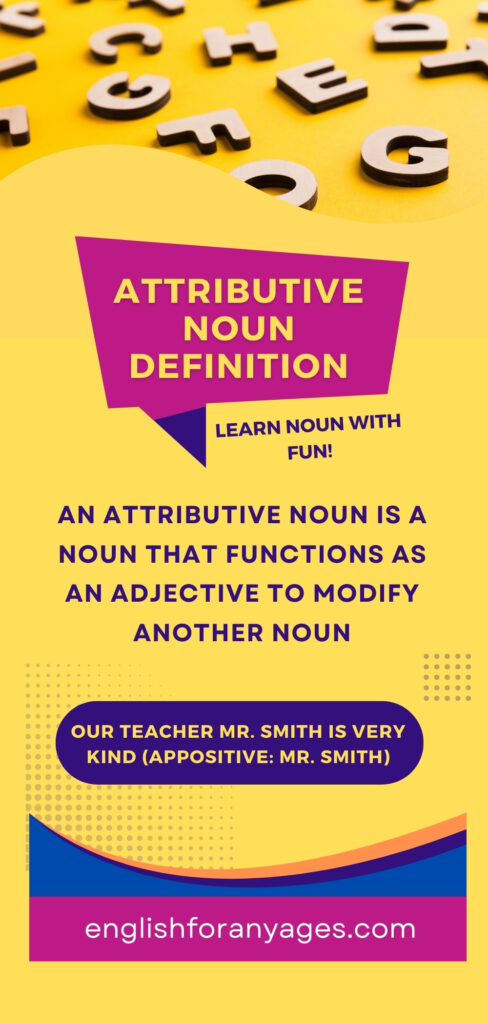
An attributive noun is a noun that functions as an adjective to modify another noun. It describes or specifies the main noun by adding additional information about it.
Attributive nouns always appear before the noun they modify and behave like an adjective, even though they are grammatically nouns.
Key Features of Attributive Nouns
- Precedes the Main Noun: The attributive noun comes before the noun it modifies.
- Functions as an Adjective: It adds detail or clarifies the meaning of the noun.
- Usually Singular: Attributive nouns are typically in their singular form, even if they refer to something plural.
Examples of Attributive Nouns with Explanations
The author J.K. Rowling wrote the Harry Potter series.
Appositive: J.K. Rowling
Explanation: The appositive renames the author and specifies who the author is.
My brother, a talented musician, performed last night.
Appositive: a talented musician
Explanation: The appositive provides extra information about my brother.
Our teacher Mr. Smith is very kind.
Appositive: Mr. Smith
Explanation: The appositive specifies which teacher is being referred to.
The Eiffel Tower, a famous landmark in Paris, attracts millions of visitors.
Appositive: a famous landmark in Paris
Explanation: The appositive adds detail about the Eiffel Tower.
The movie director Steven Spielberg is known for his blockbuster films.
Appositive: Steven Spielberg
Explanation: The appositive renames the movie director and specifies who he is.
Coffee mug
Attributive noun: Coffee
Main noun: Mug
Explanation: The word coffee describes the type of mug (a mug meant for holding coffee).
Chocolate cake
Attributive noun: Chocolate
Main noun: Cake
Explanation: The word chocolate indicates the flavor or type of cake.
Sports car
Attributive noun: Sports
Main noun: Car
Explanation: The word sports describes the type of car (a car designed for sporting activities).
School bus
Attributive noun: School
Main noun: Bus
Explanation: The word school indicates the purpose of the bus (a bus used for transporting school children).
Science project
Attributive noun: Science
Main noun: Project
Explanation: The word science specifies the field or subject of the project.
Common Uses of Attributive Nouns
Office chair
The word office describes the purpose of the chair (a chair used in an office).
Gold ring
The word gold specifies the material of the ring.
Movie theater
The word movie describes the type of theater (a theater for watching movies).
American flag
The word American indicates the origin of the flag.
Two-hour meeting
The word hour specifies the duration of the meeting.
Difference Between Attributive Nouns and Adjectives
- Attributive Nouns: Function as adjectives but are inherently nouns.
- Example: Football team (The word football is a noun describing the type of team).
- Adjectives: Are dedicated descriptive words.
- Example: Strong team (The word strong is an adjective describing the quality of the team).
Summary
- An attributive noun acts as an adjective to modify another noun.
- It adds detail about the type, purpose, or nature of the main noun.
- Attributive nouns are always placed before the noun they describe and are usually in singular form.
13. Generic Noun
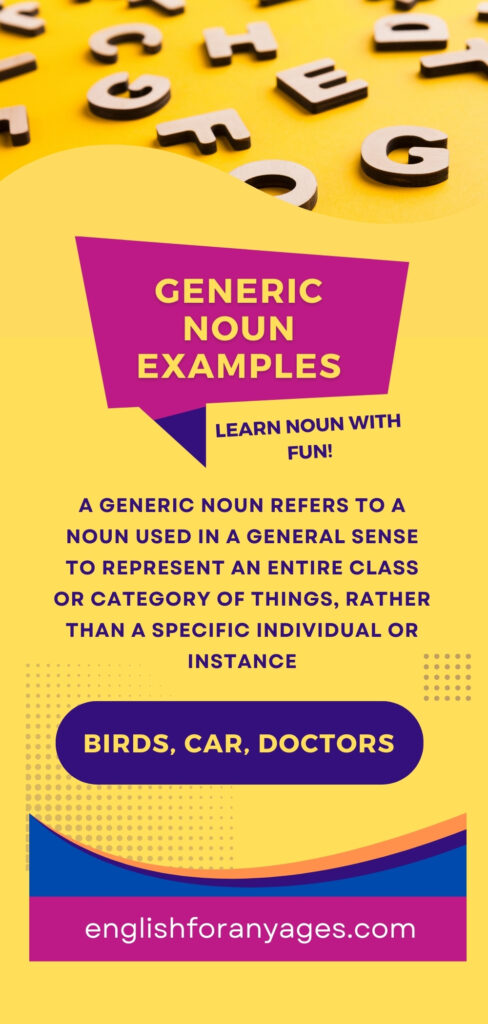
A generic noun refers to a noun used in a general sense to represent an entire class or category of things, rather than a specific individual or instance.
It does not refer to any one particular item or person but instead denotes a general idea or type.
Key Features of Generic Nouns
Example: Dog can refer to all dogs as a species or type, not one specific dog.
Explanation: A generic noun is not specific but instead describes the entire group.
Example: Singular generic nouns often require an article like “a” or “the.” Plural generic nouns refer to the entire group without needing an article.
Explanation: They can represent either one member of a group or the group as a whole.
Example: “A teacher shapes the future.”
Explanation: Generic nouns often appear in general truths, rules, or facts.
Examples of Generic Nouns with Explanation
Generic noun: Birds
Explanation: Refers to all birds in general, not a specific bird.
Generic noun: Car
Explanation: Refers to the general concept of cars, not any particular car.
Generic noun: Computer
Explanation: Refers to computers as a category, not one specific device.
Generic noun: Doctors
Explanation: Refers to the profession of doctors in general, not specific individuals.
Generic noun: Cat
Explanation: Refers to the category of cats, not one specific cat.
Generic Nouns in Context
Generic Nouns in Context
With Articles:
Singular generic nouns often use “a,” “an,” or “the” to indicate they represent the whole class.
Example: “A lion is the king of the jungle.”
Without Articles:
Plural generic nouns usually omit articles.
Example: “Lions are wild animals.”
With Uncountable Nouns:
Generic nouns can also refer to uncountable items in general.
Example: “Water is essential for life.”
Functions of Generic Nouns
Example: A plant needs sunlight to grow.
Explanation: The generic noun plant refers to all plants.
Example: Children love to play.
Explanation: The generic noun children refers to all children.
Example: The internet has changed the world.
Explanation: The generic noun internet refers to the concept as a whole.
14. Gerunds – Verb That Act As Noun!
A gerund is the -ing form of a verb that functions as a noun in a sentence.
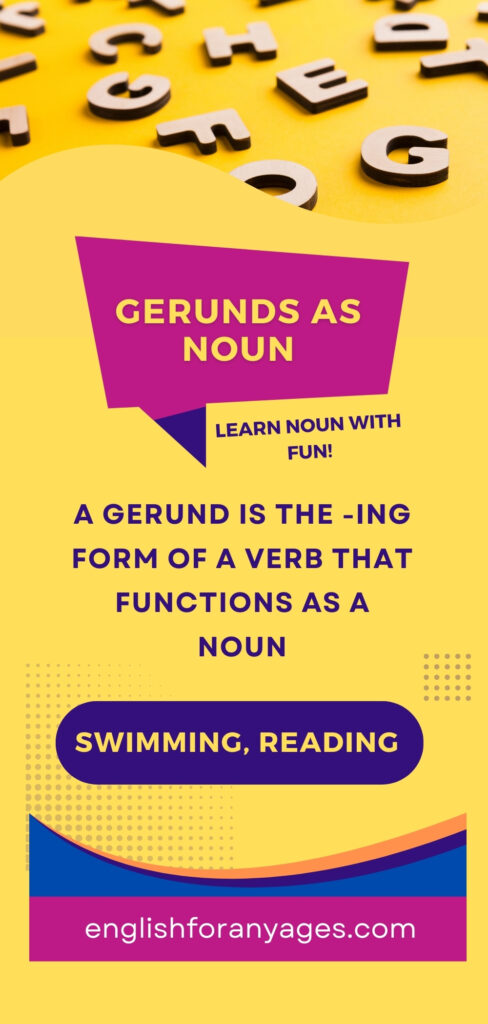
While gerunds are derived from verbs, they do not describe actions in the way verbs typically do; instead, they act as objects, subjects, or complements in a sentence.
Key Features of Gerunds
Example: Swimming (from the verb “swim”).
Explanation: Gerunds are created by adding -ing to the base form of a verb.
Example: Reading is fun.
Explanation: Despite being formed from verbs, gerunds perform the role of a noun in the sentence.
Subject: Jogging is good for your health.
Direct Object: She enjoys reading books.
Object of a Preposition: I’m interested in learning Spanish.
Explanation: Gerunds can take on multiple roles within a sentence.
Examples of Gerunds with Explanations
Gerund: Swimming
Explanation: The gerund swimming acts as the subject of the sentence, referring to the activity of swimming in general.
Gerund: Painting
Explanation: The gerund painting is the direct object of the verb “loves,” showing what she loves doing.
Gerund: Traveling
Explanation: The gerund traveling follows the preposition “in” and acts as the object of the preposition.
Gerund: Lying
Explanation: The gerund lying is the object of the preposition “for,” explaining the action he apologized for.
Gerund: Reading
Explanation: The gerund reading serves as the subject of the sentence and refers to the activity in general.
Functions of Gerunds
Example: Running is great exercise.
Explanation: The gerund running is the subject of the sentence.
Example: I enjoy dancing at parties.
Explanation: The gerund dancing is the direct object of the verb “enjoy.”
Example: He is good at singing.
Explanation: The gerund singing follows the preposition “at.”
Example: His favorite hobby is fishing.
Explanation: The gerund fishing serves as a subject complement, renaming or describing the subject “hobby.”
Gerunds vs. Present Participles
Gerunds
Function: Gerunds function as nouns.
Example: Jogging is fun. (Here, jogging is a noun.)
Present Participles
Function: Present participles function as adjectives or parts of verb tenses.
Example: He is jogging right now. (Here, jogging is part of the verb phrase.)
Summary
- A gerund is the -ing form of a verb used as a noun in a sentence.
- It can function as the subject, object, or complement of a sentence.
- Gerunds are essential for expressing activities or actions as concepts or things.
By using gerunds effectively, you can create more variety in your sentence structure and express activities or states of being in a more dynamic way.
15. Verbal Noun
A verbal noun is a noun that is derived from a verb but functions as a noun in a sentence.
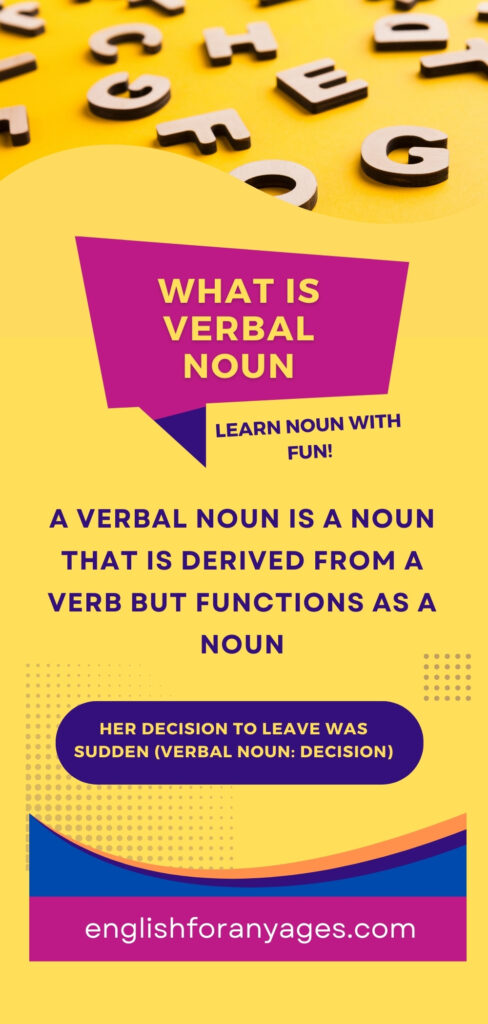
Unlike a gerund, which is typically formed by adding -ing to a verb, a verbal noun often takes a different form and can have different syntactical functions.
It represents an action or process but acts as a thing or concept.
Key Features of Verbal Nouns
Derived from Verbs
A verbal noun is formed from a verb and often conveys an action or state.
Example: Reading (from the verb “read”) or decision (from the verb “decide”).
Functions as a Noun
It functions as a noun and can be the subject, object, or complement in a sentence.
Example: “I enjoy reading.” (“Reading” is the object of the verb “enjoy.”)
Can Take Determiners and Modifiers
Verbal nouns can be preceded by articles (a, the) or other determiners and can also be modified by adjectives.
Example: “The running of the marathon was exhausting.”
Differences Between Gerunds and Verbal Nouns
Gerunds
Function: Gerunds describe an activity or process in a general sense. They mainly function in specific grammatical roles such as subjects or objects of verbs and prepositions.
Example: Swimming is fun. (“Swimming” is the subject of the sentence.)
Verbal Nouns
Function: Verbal nouns often have more noun-like qualities. They can take possessive forms, be pluralized, and are used in more formal or abstract contexts.
Example: The swimming of the athletes was impressive. (“Swimming” is a noun and can be pluralized as “swimmings.”)
Examples of Verbal Nouns with Explanation
Examples of Verbal Nouns with Explanations
Verbal noun: Decision
Explanation: Decision is derived from the verb “decide” and functions as a noun. It is the subject of the sentence, referring to the act of deciding.
Verbal noun: Running
Explanation: Running refers to the action of managing or organizing the event, and it functions as a noun.
Verbal noun: Complaining
Explanation: Complaining is derived from the verb “complain” and functions as the object of the verb “like.” It represents the action of complaining.
Verbal noun: Offer
Explanation: Offer comes from the verb “offer,” but here it functions as a noun, referring to the act or instance of offering.
Verbal noun: Building
Explanation: Building refers to the action of constructing something (in this case, the house), and it functions as the object of the preposition “of.”
Functions of Verbal Nouns
Functions of Verbal Nouns
As the Subject of a Sentence:
Writing is the subject, referring to the activity of writing as a thing or concept.
As the Object of a Verb:
Dancing is the object of the verb “enjoys,” referring to the activity she enjoys.
As the Object of a Preposition:
Improving is the object of the preposition “for,” referring to the act of improvement.
With Possessive Forms:
The verbal noun passing takes the possessive form “her,” which is a unique feature of verbal nouns. This is common when referring to actions done by specific people.
Summary
- A verbal noun is a noun derived from a verb but functions as a noun in a sentence.
- It can be formed from a verb and may take forms like reading, decision, or running.
- Verbal nouns can take determiners, modifiers, and possessive forms, and they can be used in both formal and informal contexts to describe actions as things or concepts.
Why Nouns Are Important in English Grammar
Nouns help construct meaningful sentences, serve as subjects and objects, and connect ideas. A solid understanding of nouns enhances your writing, speaking, and comprehension skills.
Common Mistakes with Nouns and How to Avoid Them
- Confusing singular and plural forms.
- Using the wrong quantifier with countable or uncountable nouns.
- Misplacing possessive apostrophes.
Practice Exercises
- Identify the nouns in this sentence: The artist painted a beautiful landscape with mountains and rivers.
- Convert these singular nouns to plural: fox, child, box, man.
Lets Practice and Learn!
Let me know if you need any more help about noun. But I hope this info is enough for you to get a clear idea about noun and its types.
Let begin practice with our worksheet. We’re here for your 24/7 help.
